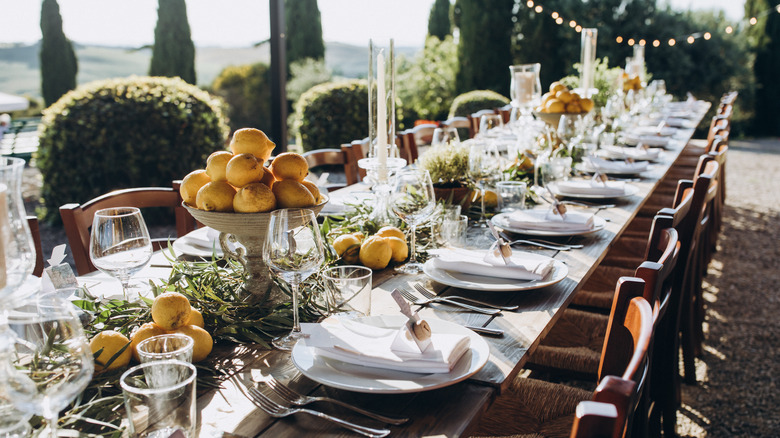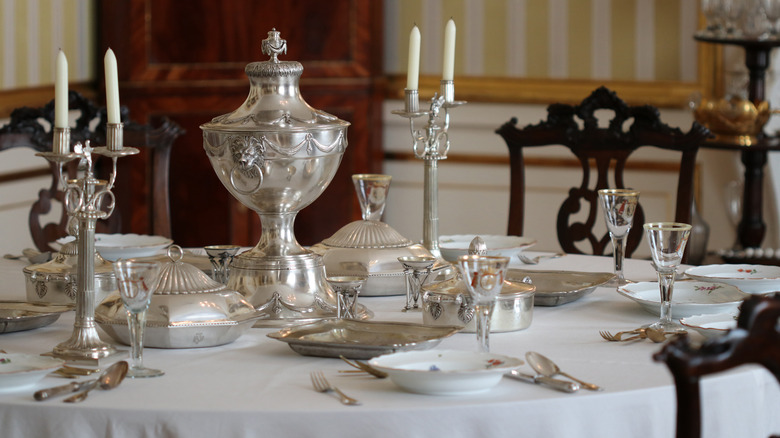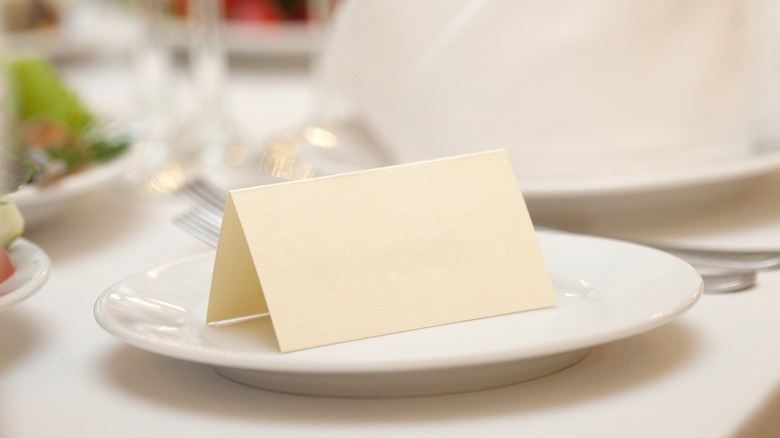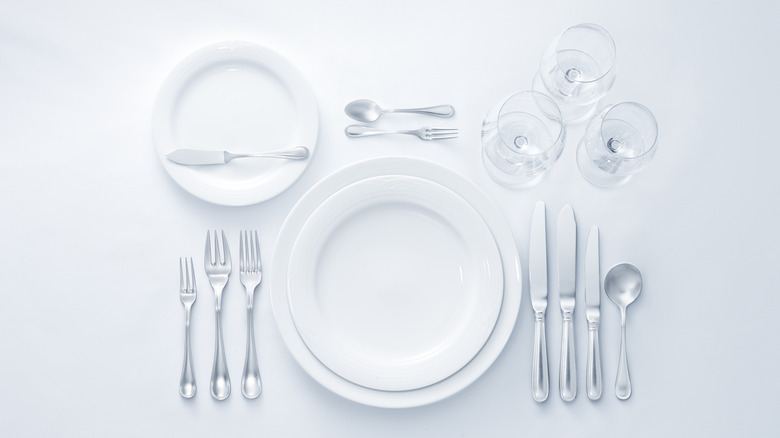Table Setting Rules You Should And Shouldn't Follow
There's nothing like a good, old-fashioned, somewhat fancy dinner party. But if you look at some of the guidelines and diagrams for what the perfect dinner party table should look like, it can make you reconsider inviting anyone over in the first place.
Luckily for the easily overwhelmed, the sort of table boasting a charger, oyster fork, and sherry glass is on its way out, if it isn't already obsolete in some circles. These days, we're all for a much easier-to-manage laid-back vibe. Many dinner party hosts now opt for a buffet or family-style table in place of the plated dinner that was once the norm. What's more, hosts are more likely to ask their guests to grab a plate and serve themselves rather than sit before an impeccably curated table. Who's got waitstaff anyway? Some may be intimidated by what they feel are a ton of etiquette rules, which can feel even more daunting if they're dining somewhere outside of their home country.
That said, if you are setting a table — yes, even a basic one — know that not all of the Miss Manners etiquette rules of yore should go entirely out the window. Here are some of the table setting guidelines that experts are still wholeheartedly in favor of, along with the ones we all think it's high time to forget.
Do: Consider the vibe
You wouldn't set the table the same way if you invited your friends around for lasagna as if you were having your in-laws over for the first time, would you? So, it stands to reason that there are different approaches to setting the table, depending on the atmosphere or vibe you're seeking to achieve. Ultimately, that's something you'll need to consider before you even open the china cupboard.
Real Simple offers three different categories of dinner parties, complete with three drastically different table setups: basic, casual (or semi-formal), and a full-on formal table setting. Emily Post offers a similar guide, so you can choose the aesthetic you like best. From a basic table setting with just one set of utensils, one glass, and one plate, to the more ornate formal dinner table with multiple sets of cutlery, glasses, and even a personal bread plate, what goes where depends on the kind of event you're hosting. Settle on that before anything else, and you'll be in a good place to move forward with the menu. Only after that will you be ready to think about how the table should best be set.
Do: Seat couples separately
One accouterment you'll find on some dinner party tables is a place card. Sure, it may seem a bit stuffy, but if you want to encourage lively conversation, you'd do well to include them even in modern times. Using place cards allows the host to consider the flow of conversation — not to mention possible conversation topics — and plan accordingly. You won't want to seat your shy friends far from the action, for instance. Neither is it necessarily wise to seat two guests who are on wildly different ends of the political spectrum next to one another. But what should be of utmost importance when crafting your seating chart? Separating couples.
Admittedly, this one is a divisive etiquette rule that some think should be trashed. We get it! Some guests will surely be surprised to show up with a plus-one, only to find that their partner is sitting at the opposite end of the table. But as Miss Manners says, separating couples allows them to tell their shared stories without fear of being contradicted!
In all seriousness, splitting up couples is a great way to encourage diners to be more social and get to know new people at a get-together. Otherwise, you run the risk of everyone staying in their established social relationships and allowing the evening to turn into a cliquey bore. And isn't meeting new and interesting people at least half the fun of a dinner party, anyway?
Do: Offer multiple glasses
At a fancier affair, you may find yourself confronted with three, four, or even five glasses over the course of an evening. But, for a home event, there's no need to go quite so overboard. That said, no matter if you're setting a casual or formal dinner table, it's a good idea to have, at minimum, two glasses per guest. This set would include one vessel for wine and one for water. The water glass, as etiquette expert and coach Myka Meier tells Martha Stewart, should be right above the main dining knife. Meanwhile, the wine glass should sit just to the right of the water glass.
But what if you want to serve more than one wine? And what if your table isn't exactly sized to fit a manor's dining hall? According to Wine Enthusiast, while white wine glasses typically have smaller, narrower bowls than red wine glasses, you don't really need to overthink things. To reduce overcrowding of the table, just pick the stemware that you like best. The only caveat? If you're switching wines partway through the dinner (or if you have a guest who'd like to do so of their own accord) you should at least offer to swap out the used glasses for fresh ones.
Do: Offer wine glass tags
If there's an hors d'oeuvre or cocktail hour portion of your party — or, really, any point at which people will be carrying their glasses from one point to another — consider offering charms or labels for those glasses. This way, your guests will get a little assist to keep them from losing track of whose glass is whose.
Let's face it: No one wants to lose their wine glass at a dinner party, especially these days. What's more, there are loads of fun wine tag options out there, from charms to labels to special markers that write directly on glass but thankfully wash off later. Letting each guest choose his or her special identifier can be a fun icebreaker, for one. And, of course, such a move will help each guest easily identify their glass over the course of the evening. This also keeps the host or some other unfortunate from spending half the night up to their elbows in dish soap, all because people couldn't identify their drink from among a plethora of abandoned, half-full glasses.
Do: Include multiple sets of flatware for different courses
To avoid overwhelming your guests with an array of nearly identical forks, spoons, and other tools, it's probably a good idea to pare back the too-cumbersome flatware arrangements. However, that doesn't necessarily mean you should go straight from a potentially overwhelming four forks to just one! When considering your menu, you may decide to offer a set of flatware for each course, especially if the dishes you're serving are very saucy (no, not like that!) or have distinctive flavors that you don't want to overlap.
As a rule, you should set the table with the outermost pieces of flatware being the ones you use first. For example, if you're serving salad to start and roast chicken to follow, traditionally, you'd include two forks (one for salad, one for chicken) on the left side of the plate. You would then want to add in two knives (again, one for salad, one for chicken) to the right. No spoons are needed in this case, of course, but if you're serving chocolate mousse for dessert, you'll want to add one. And, as with all dessert cutlery, the spoon in question should be positioned at the top of the plate.
Don't: Go overboard on flatware
Though some people insist that you need a dedicated set of utensils for each course, perhaps that's still too much for you and yours. And these days, there's no need to stand on ceremony for the vast majority of dinner parties. If you want to keep your dinner table fairly simple (and avoid overwhelming your guests), you can pare back the flatware to the bare minimum, says Yahoo Money. This means that just a fork, knife, or spoon each for sweet dishes, as well as another simple set for savory ones. And that should do the trick! This means that guests will use the same fork and knife for all savory courses (even if there are two or three), swapping them out for clean cutlery when it comes time for dessert.
In any case, the same rules of placement apply: cutlery for savory courses goes next to the plate (fork to the left, knife and spoon to the right) and dessert cutlery goes up top, above the plate. The only caveat is that, if you're serving meat that requires a steak knife, such as steak, duck, or lamb chops, consider adding a second knife or giving people only a steak knife instead of a duller one.
Don't: Overwhelm the table with a too-tall centerpiece
If we had a nickel for every time Sandra Lee built an ostentatious centerpiece on the Food Network back in the day ... well, let's just say that we'd have a lot of nickels. And we'd use them to hire a moving company to come to take the rather unnecessary centerpieces away.
Look, it's not that there's anything wrong with wanting a table to be beautiful. It's just that massive centerpieces can start to take away from the point of the evening. That is, they kind of defeat the point of your dinner party, in that too-large centerpieces often take up space that would otherwise be used for food and can block diners from seeing one another while they attempt to converse. Sometimes, especially in the case of floral centerpieces, they can even compete with the food in terms of aroma. No one wants to try to eat salmon with lilies just under their nose!
To be perfectly pragmatic, centerpieces can also be costly. To top it all off, often they aren't all that sustainable, according to Green Matters. So, if you've got the decorating urge, go ahead. Just keep things simple with some low candles or plants with no aroma. You could even craft your own edible centerpiece to do double duty as an hors d'oeuvre and a tablescape.
Don't: Worry about alternating genders
These days, most hosts don't stand on ceremony. Gone are the place cards of yore, and instead, guests are frequently invited to seat themselves. Others still rely not just on place cards but on seating charts, which have the benefit, notably, of allowing the host or hostess to separate couples or unite strangers who might share a common interest. If you fall into the latter camp (and if you want to do your shy friends a favor, we highly recommend you do), please do put at least one table seating rule to bed: Stop staggering men and women.
We understand the original idea behind this seating arrangement, which keeps genders from self-segregating at opposite ends of the table and therefore dividing the dinner party in half. But these days, men and women aren't as divided in society as they once were. And it's key to note that not everyone may identify as one or the other — you may very well have nonbinary guests who wouldn't appreciate being put into a gender box. So staggering folks at the dinner table nowadays feels old-fashioned and just kind of "off."
So, what to do? Maybe don't think about it too much at all. Food52 recommends separating couples and leaving it at that. Instead, consider seating people according to their shared interests. You may also want to seat your shyer friends near more extroverted people who you know will help them participate in the conversation more easily.
Don't: Correct people who get it wrong
Okay, so you've reviewed everything and feel you know how to get the perfect tablescape ready. You've set your table impeccably and spent hours agonizing over your seating chart so that your guests are perfectly placed. You picked the meal. You arranged the (not-too-tall) centerpiece. Then your brother's girlfriend goes and takes the water glass to her left instead of her right. It's annoying ... but the worst thing you can do is correct her in front of everyone (and, hey, maybe she's left-handed).
The whole point of etiquette is to avoid this. If everyone knows the rules, after all, they will rarely get broken. But since such rules are fading and are often considered pretty old-fashioned, to begin with, folks are bound to make mistakes. As a good and gracious host, your job is to just ... let them. Etiquette, as Sharon Schweitzer tells Martha Stewart, is "fluid, and rests on a foundation of consideration, respect, and honesty." Correcting someone publicly, then, is a major faux pas.
The best thing you can do as the host at a party where someone has made a misstep is to help everyone adjust — by offering a new glass to the person who's had theirs usurped, for instance — and simply move on with a smile. Ultimately, it's more about having a good time and making connections with friends old and new, rather than fretting over whether or not they're using the right fork.









